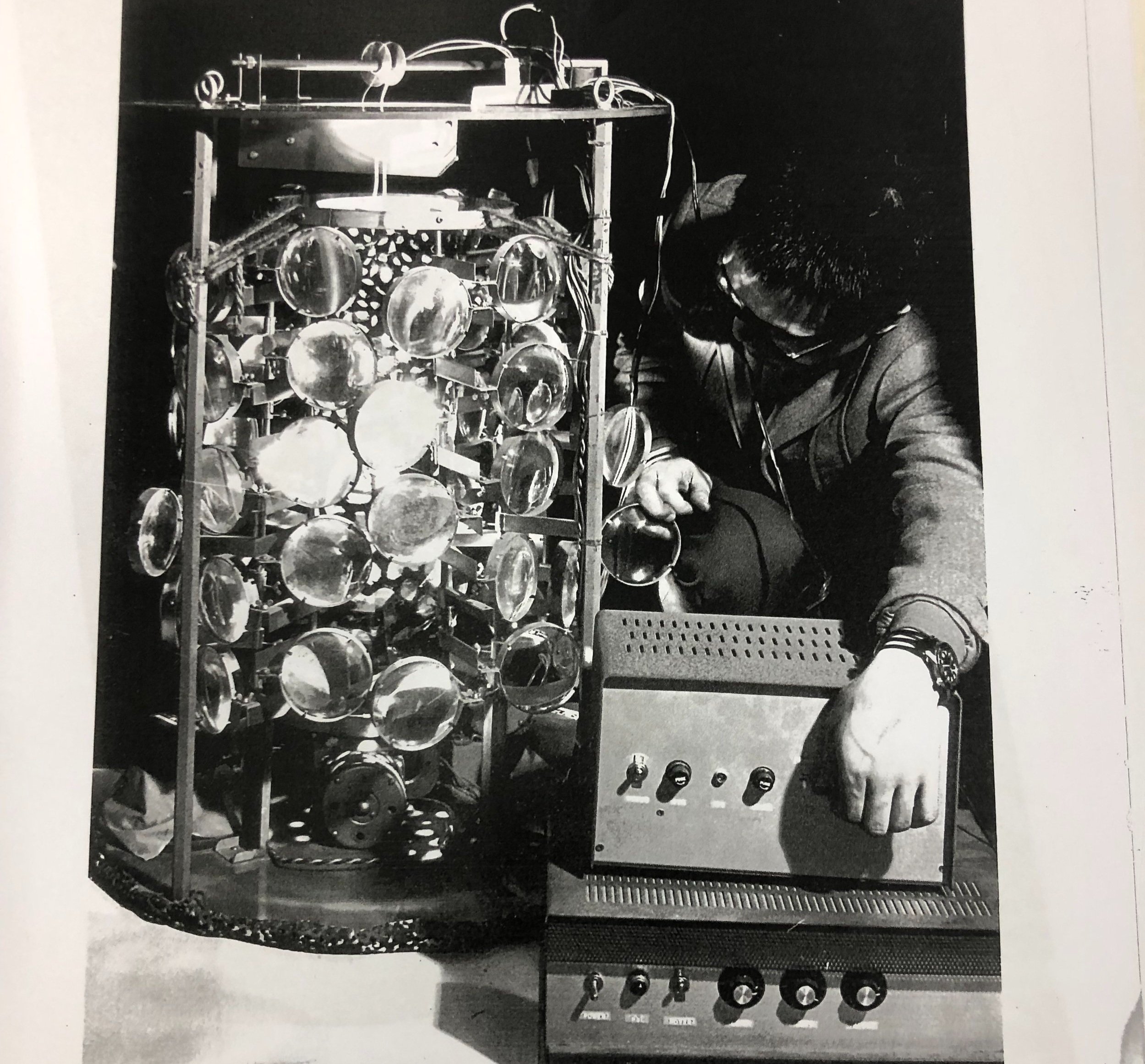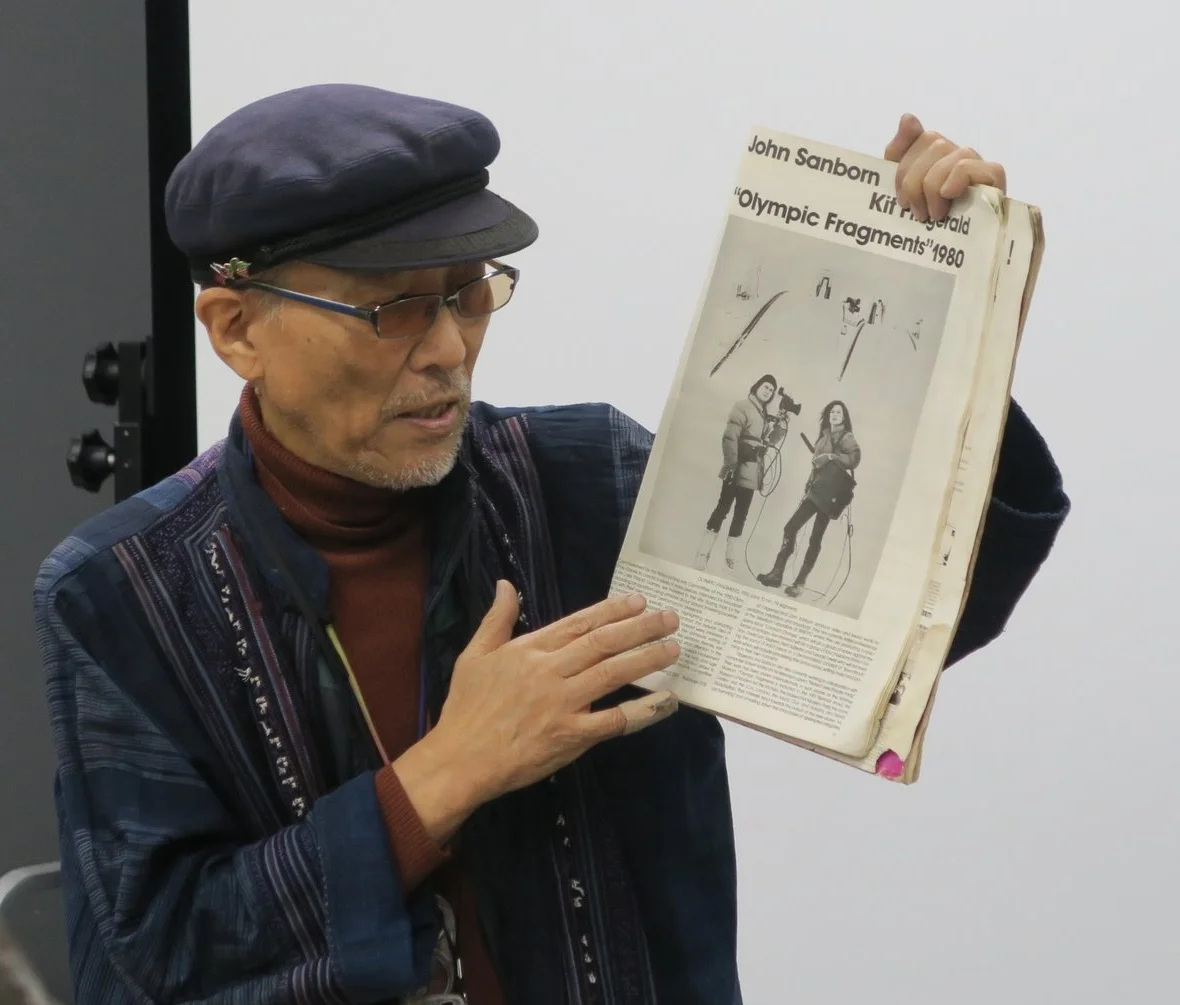
Interview: Ko Nakajima
As part of the Community of Images exhibition, we conducted an interview with artist Ko Nakajima in 2023.
interview: Ko Nakajima
As part of the Community of Images: Japanese Moving Image Artists in the US, 1960s-1970s exhibition, we conducted an interview with Ko Nakajima in Tokyo in March 2023.
Part 1
Ko Nakajima Interview Part 1
Part 1 Notes
*1. In 1967, Nakajima traveled to Canada to participate in the Montréal International Film Festival at Canada’s Expo 67. The festival had solicited one-minute videos inspired by Antoine Saint-Exupéry’s Wind, Sand and Stars, which was the theme of the Expo. Nakajima submitted Seimei no sanka [Ode to Life], co-created with Kozo Sasagawa, and won a silver award. According to a flyer created by Nakajima, the top award went to a Czech film, and Seimei no sanka was ranked second among nine silver award winners (meaning it was effectively in third place among all films).
Nakajima had been making the rounds of embassies in search of film festivals where he could submit his work. He learned of this festival at the Canadian Embassy, and produced a short film specifically for the festival. The film depicted a heart surgery on a Japanese boy, while the top entry among the silver award winners focused on the theme of war in India.
*2. Nakajima produced Biological Cycle in 1971. The work he brought with him in 1967 is thought to be either Anapoko (1963) or Seizoki (1964).
*3. John Sanborn and Dan Sandin began using computers extensively in the 1970s, and their interactions with Nakajima are believed to have occurred later than this.
*4. ADO (Apex Digital Optics) was released in 1981.
*5, 6. Nakajima worked on the title animation for the TV program News Center 9 in 1979. Kinji Odaka, an engineer at Toyo Genjosho (now Imagica Lab), was also involved in the project.
*7. Lauryn Heyer was among the SIGGRAPH commissioners in 1985 and 1987.
*8. Nam June Paik’s second satellite broadcast program, Bye Bye Kipling (1986), was aired in 1986. In Japan, TV Asahi took part in production, and Nakajima provided footage from Mont Fuji (1984). It is believed that there were multiple producers involved on the Japanese side.
*10, 11. In December 1974, Nakajima participated in the BIFFF (Brussels International Fantastic Film Festival). While the festival mainly focused on screenings, according to Nakajima, Paik exhibited a three-dimensional work. It involved projecting live camera footage onto a spherical monitor, and the phrase “deformed face” refers to Nakajima’s own face as he approached the apparatus.
*12. In 1979, Nakajima collaborated with Sony to develop the Animaker, a video camera capable of stop-motion. The product demonstration video was produced by Michael Goldberg.
*13. In 1982, Nakajima partnered with JVC to develop the Aniputer, a device designed to apply computer graphic effects to magnetic tape. He used it to create the video game Metamorphosis (1982), as well as the aforementioned Mont Fuji. That same year, he visited MIT to demonstrate the Aniputer.
Part 1 Notes (Japanese)
*1 1967年、中嶋はモントリオール短編映画祭に参加するためカナダに渡航する。映画祭ではモントリオール万博のテーマであったサン=テグジュペリの『人間の土地』を題材にした1分の映像を募集しており、中嶋は笹川弘三と制作した『生命の讃歌』を出品し、銀賞を受賞した。中嶋自身が制作したチラシによると、1位はチェコの作品であり、銀賞は全9本ある中で、『生命の讃歌』は2席(実質3位)だったという。
中嶋は当時、様々な大使館を訪ね歩いて出品可能な映画祭を探しており、カナダ大使館で映画祭の存在を知り、応募のために制作を行う。日本人の少年の心臓手術を撮影したもので、銀賞における1席がインドの戦争を扱うものだった。
*2 『生物学的サイクル』の制作は1971年。67年に持参した作品は『穴ポコ』(1963)、もしくは『精造器』(1964)と思われる。
*3 ジョン・サンボーンとダン・サンディンが本格的にコンピューターの活用を始めるのは70年代であり、彼らとの交流は後年のエピソードと思われる。
*4 ADO(Apex Digital Optics)の発表は1981年。
*5、6 1979年、『ニュースセンター9時』のタイトルモーションを制作。東洋現像所(現IMAGICA Lab.)のエンジニアだった小高金次氏が協力した。
*7 ローリン・ヘア。1985年、87年におけるSIGGRAPHのコミッショナーの一人。
*8 1986年、ナム・ジュン・パイクによる2つ目の衛星中継番組『バイ・バイ・キップリング』(1986)が放送された。日本ではテレビ朝日が制作に携わり、中嶋は『Mt. Fuji』(1984)の映像を提供した。日本側のプロデューサーは複数いたと思われる。
*10、11 1974年12月、ベルギー国際実験映画祭に参加する。この映画祭は上映を主としていたようだが、中嶋によるとパイクが立体作品を出品していたという。カメラの映像をリアルタイムで球体モニターに映す作品で、「デフォルメされた顔」というのは装置に近づいた中嶋自身の顔を指す。
*12 1979年、コマ撮りができるビデオカメラ「アニメーカー」をSONYと開発する。製品のデモ映像をマイケル・ゴールドバーグが制作した。
*13 1982年、磁器テープにCGエフェクトをかける機器「アニピューター」をJVCと開発する。中嶋はこれを用いてビデオゲーム『メタモルフォーシス』(1982)、『Mt. Fuji』を制作した。同年、アニピューターのデモストレーションのためにMITを訪問した。
Part 2
Ko Nakajima Interview Part 2
Part 2 Notes
*1. Around 1968, Nakajima initiated a group and a series, both called Ryūdōtai [Liquid], with young collaborators that he got to know at an event . They made objects by placing colored liquids inside large lenses and glass constructions, and combined these with homemade projectors and commercial slide machines to project moving images. The group held a projection event at the Shinjuku Education Center planetarium circa 1969.
*2. Thought to refer to Club JUDO, which opened in Akasaka in 1969.
*3. In 1970, Nakajima was involved with the Mitsui Pavilion and the Ricoh Pavilion at Expo ’70 Osaka. He served as video director for the Mitsui Pavilion, where he developed a projection device featuring movable lights used at the venue. Several artists contributed videos for balloons at the Ricoh Pavilion.
*4. In November 1964, the Merce Cunningham Dance Company performed in Japan at the Sogetsu Art Center. Nakajima’s first involvement with Sogetsu was in October 1965, when he submitted Seizoki to Animation Festival ’65. At the time of his guerrilla-style participation in the rehearsal, his connection with Sogetsu was still in a formative stage.
Part 2 Notes (Japanese)
*1 1968年頃、イベントで知り合った若者たちとともに「流動体」というグループおよびシリーズを始める。巨大なレンズやガラスによる造形物の中に着色した液体を入れたオブジェを作り、それらと自作のプロジェクターマシンや既製のスライドマシンなどを組み合わせて映像の投射を行った。1969年頃、新宿区立教育センターのプラネタリウムで、プロジェクションを用いた上映イベントを開催している。
*2 1969年、赤坂にオープンしたclub JUDOのことと思われる。
*3 1970年、大阪万博の三井館、リコー館に参加。三井館では映像ディレクターを務め、可動式ライトによるプロジェクション装置を開発し、会場で使用した。リコー館のバルーンには複数の作家が映像を提供した。
*4 1964年11月、草月アートセンターでマース・カニングハム・ダンス・カンパニイの来日公演が開催された。中嶋が初めて草月に関わるのは、1965年10月「アニメーション・フェスティバル ‘65」への『精造器』出品であり、リハーサルへのゲリラ参加は、まだ草月とのコネクションが浅かった時期にあたる。
Part 3
Ko Nakajima Interview Part 3
Part 3 Interview Notes
*1. Around 1965, during his first trip to Canada, Nakajima visited the National Film Board (NFB) and toured Norman McLaren’s studio. Evidently he had first met McLaren at a screening at the Canadian Embassy around 1962, when Nakajima was a student at Tama Art University. After learning about camera-less animation techniques in Canada, Nakajima began collecting discarded film from processing labs and producing his own animations.
*2. In Japan, art exhibitions at department stores are common. Notably, Studio 200, which opened in 1979 at the Seibu Department Store in Ikebukuro, was the venue for many exhibitions involving video. Nakajima participated in Japan-US Video Art (May 10-18, 1980).
*3. / Part 1 *12. In 1979, Nakajima collaborated with Sony to develop the Animaker, a video camera capable of stop-motion. The product demonstration video was produced by Michael Goldberg.
Part 3 Interview Notes (Japanese)
*1 1965年頃、初めてカナダに行った際にNFBを訪ね、マクラレンのアトリエを見学する。中嶋が初めてマクラレンに会ったのは1962年頃、多摩美術大学の学生時に開催されたカナダ大使館での上映会だったという。そこでカメラレス・アニメーションの手法を知った中嶋は、現像所の廃棄フィルムを拾いに行き、アニメーションの制作を始める。
*2 日本ではしばしばデパートで美術展が開催される。とくに1979年にオープンした「スタジオ200」(池袋・西武百貨店)では、映像を用いた展示が多く催され、「日米ビデオアート展」(1980年5月10日~18日)に中嶋も出品した。
*3/Part1 *12 1979年、コマ撮りができるビデオカメラ「アニメーカー」をSONYと開発する。製品のデモ映像をマイケル・ゴールドバーグが制作した。

